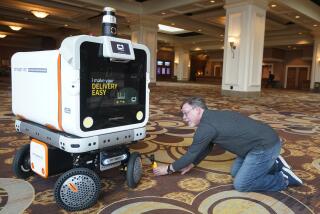Growth in ‘green,’ Web forecast
- Share via
LAS VEGAS — Though 2009 looks just as grim as 2008, organizers of the Consumer Electronics Show last week forecast a few rays of sunshine.
The Consumer Electronics Assn. projected growth in organic LED displays, digital book readers, Blu-ray disc players and lightweight laptops called netbooks. Despite a projected 0.3% decline in overall consumer spending in 2009, the trade group said, people will continue to earmark a large chunk of their income for technology.
“Technology’s share of consumer spending compared to other durable goods has never been this high going back to the 1960s,” said Shawn DuBravac, CEA’s chief economist.
That share is expected to grow, he said, thanks to four technology trends unfolding in 2009: environmentally friendly electronics, wireless gadgets that can be used in more places, expanded access to the Internet and newer ways for people to interact with their devices, including voice commands and gestures.
But as consumers delay, substitute or forgo purchases, some categories will take a hit. Consumers may put off buying desktop computers or substitute a less expensive netbook or laptop. Other categories feeling the pain include aftermarket car audio and home audio systems, DuBravac said.
--
This is the city where old stars come to resurrect themselves, and Palm Inc. delivered on its promise to impress. The company announced a new smart phone, the Pre, that became the talk of the show, and a new platform called Web OS.
Palm helped pioneer hand-held devices, but its Treo has struggled to keep pace with such smart phones as Apple Inc.’s iPhone. The Pre, which features a slide-out keyboard and touch screen, allows users to surf the Web, send e-mail and listen to music. Palm will sell it sometime in the first half of the year. Its initial wireless partner is Sprint Nextel Corp.
“With what they had before, they basically were not relevant in the market,” Creative Strategies analyst Tim Bajarin said. “Whereas now with this new operating system and device . . . they could come back and become a force eventually.”
--
Somewhere between a cellphone and a laptop is Sony’s new offering: the Vaio P Series Lifestyle PC.
Vaio P could stand for “pocket” -- or “purse.” It’s a computing device but definitely not a full-service computer. It’s light -- only 1.4 pounds -- and offers users connections through integrated wireless WAN, LAN and Bluetooth. There’s built-in GPS for navigation and an 8-inch LED backlit screen.
--
WowWee introduced Cinemin, a line of hand-held micro-projectors due this spring.
You can connect your iPod, Flip or other portable video player and project an image measuring up to 60 inches onto a surface up to 12 feet away. The bedroom blinds could be your movie screen.
So on that flight that no longer offers you a movie and a meal, you could pack your own movie and popcorn. The world is your screen.
--
Wireless induction chargers, which juice up electronics without having to plug them in, are nothing new. Electric toothbrushes have used the technology for years. Until recently, however, the method was too slow for power-hungry cellphones, cameras and laptops.
The latest crop has finally caught up to the traditional plug-in-the-wall method. The allure: They free users from having to keep track of their chargers and untangling a rat’s nest of power cords.
Powermat showed off how its offerings could charge iPods, hand-held game consoles, cellphones and laptops all at once.
Of course, the mat itself needs to be plugged into the wall, so it’s not completely wireless. But it does reduce the number of wires required to charge devices.
--
michelle.maltais@latimes.com







